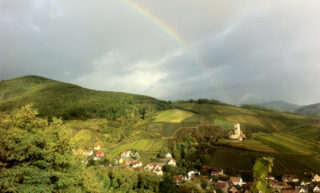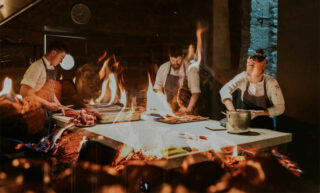ÖTW works on a location based classification for Austria
In wine, as in so many things, location is everything, with soil and bedrock as well as orientation, micro-climate and inclination of the vineyard deciding factors for quality. Yet, unlike Burgundy’s well-estab listed terroir-based classification system, and Germany with its VDP wineries and their Große Gewächse (Grand Crus or Great Growths), Austria doesn’t have a similar system. But that is changing.
Indeed, the Österreichische Traditionsweingüter (ÖTW, or Austrian Traditional Wineries) have taken it upon themselves to identify the best spots for growing Rieslings and Grüner Veltliners. Comprising 36 ambitious wineries from Kamptal, Kremstal, Traisental and Wagram, the ÖTW has been discussing the merits of certain vineyards over others since 1992, building upon the existing system of Gebiets-, Orts- and Riedenweine (regional, village and single vineyard wines). The result of this thorough process is 72 choice plots, including recent additions in Vienna and Carnuntum, which now carry the coveted classification Erste Lage, or First Growth. Eventually, a subset of the finest will be promoted to Große Lage, a term comparable to Germany’s Großes Gewächs.
Placing terroir at the center of the evaluation, the ÖTW is shifting away from the traditional criteria of sugar content in the grapes. Loess soil typically yields grapes that make creamier, rounder Grüner Veltliners, while crystalline rocks provide mineralogy and marine deposits a smidgen of salinity. An eastern exposure, with morning sun and cooler nights, adds freshness, as does the proximity of forests and cool breeze, which keeps the temperatures in vineyards lower.
Terroir, clearly, implies a multitude of factors that influence the development of the vines. Although not all of them are firmly supported by scientific proof and some cynics claim that terroir-centered classification is merely a marketing tool, most self-respecting wine buffs would agree on the essence of terroir and the added value for the consumer.
The ÖTW’s first step was to select its best vineyards, its Erste Lagen, out of the existing, acknowledged Riede, or single vineyards. This was predominantly based on their vintner’s own experience, often passed on for generations. Other factors, such as market price and a vineyard’s heritage, were also taken into account at this stage. As these account for only 15-20 percent of the ÖTW’s single vineyards, the selection was rigorous, but well-known vineyards such as Heiligenstein, Gaisberg and Käferberg made the list in 2010.
For the identification of Große Lagen, the ÖTW also invokes the opinion of third-party wine professionals. Every September since 2011, it invites a group of prominent sommeliers and journalists to Schloss Grafenegg – METROPOLE among them this year – to taste and compare its newly released Erste Lage Rieslings and Grüner Veltliners, taking terroir into consideration.
Schloss Grafenegg
So what did we learn? Although terroir has a distinctive influence on wine, it is not the single most determining factor. While the Riesling from Pfaffenberg by Stift Göttweig was remarkably dry and low on fruitiness, Rainer Wess’ Riesling from the same Lage was the opposite and Salomon Undhof held the middle ground. Although the current trend is toward minimal intervention in the cellar, the process of vinification can apparently hide the identical terroir. On the other hand, most of the 12 wines from Heiligenstein revealed – in some shape or form – the sandstone where their vines are rooted.
When the Große Lagen will be announced is still shrouded in uncertainty – most likely in 5 to 10 years – but for now, tipplers can recognize Erste Lagen wines by the 1ÖTW logo and the name of the Lage, or Ried, on the label; a badge of honor for Austrian wine’s swankiest neighborhoods.
THE CREAM OF THE CROP
Although some critics felt the quality of the 1ÖTW 2017 wines was a bit more variable than last year, there was very little I rated low. Here are some of my personal favourites.
Weingut Hirsch
Ried Gaisberg Kamptal 1ÖTW GRÜNER VELTLINER 2017
Hauptstraße 76 – Kammern (Austria)
T: +43 2735 2460 weingut-hirsch.at
Weingut Jurtschitsch
Ried Heiligenstein Kamptal 1ÖTW RIESLING 2017
Rudolfstraße 39 – Langenoogs (Austria)
T: +43 2734 2116 jurtschitsch.com
Weingut Bründlmayer
Ried Käferberg Kamptal 1ÖTW GRÜNER VELTLINER 2017
Zwettlerstraße 23 – Langenlois (Austria)
T: 2734 2172-0
Weingut Markus Huber
Ried Berg Traisental 1ÖTW GRÜNER VELTLINER 2017
Weinriedenweg 13 – Reichersdorf (Austria)
T: +43 2783 82999
Weingut Bernhard Ott
Ried Spiegel Wagram 1ŌTW GRÜNER VELTLINER 2017
Neufang 36 – Feuersbrunn am Walgram (Austria)
T: +43 2738 2257
Österreichische Traditionsweingüter Region Donau
c/o Kloster Und
Undstrasse 6 – Krems-Stein (Austria)
E: info@traditionsweingueter.at
A slightly altered version of this article was published in Metropole – Vienna in English, October 2018 issue no. 31.





Comments